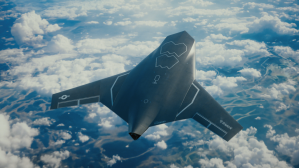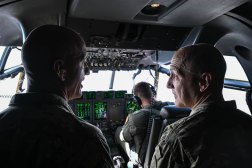Inside the AI-enabled pilot that flew Air Force Secretary Kendall through a dogfight

On May 2, Secretary of the Air Force Frank Kendall boarded a modified F-16 fighter jet equipped with specialized artificial intelligence and machine learning capabilities that enabled the aircraft to autonomously fly and perform tactical maneuvers against human pilots.
The event was part of a larger Air Force effort to develop, test and mature autonomous capabilities that can eventually be integrated onto the service’s platforms, and Kendall’s demonstration flight marked another step in understanding how to bring AI-enabled operations from computer simulation into real-world applications to meet the department’s goals.
During the exercise over Edwards Air Force Base in California, an autonomous agent developed by Shield AI was integrated onto the X-62A VISTA (Variable In-flight Simulator Test Aircraft) that engaged with a manned F-16 in a within-visual-range air combat scenario — also known as a dogfight. While Kendall sat in the VISTA’s front seat, a human safety pilot sat behind him for the duration of the flight in case something went wrong and they needed to intervene.
For the demonstration, Shield AI put a technology known as reinforcement learning-based artificial intelligence onto the aircraft, Brett Darcey, executive vice president and head of product at the company, told DefenseScoop in a recent interview. The AI agent is a direct descendant of one used by Heron Systems — bought by Shield AI in 2021 — to win the Defense Advanced Research Projects Agency’s AlphaDogfight Trials competition in 2020.
Since then, Shield AI has continued working with DARPA through its Air Combat Evolution (ACE) program to transition the technology to live aircraft through a number of real-world flights.
“We’ve proven a method for going from our laboratories to live airplanes. We’ve proven the method to both get the technology there, but also for our people to support some of the compliance and testing and verification pieces you need to do,” Darcey said. “We’ve proven that model, that reinforcement learning can fly and it is successful. And we’ve proven that the way we approach the problem is scalable.”
Reinforcement learning-based AI is a machine learning technique that trains algorithms to achieve a desired outcome using a trial-and-error process that mimics how humans make decisions. By “rewarding” positive behaviors and “punishing” negative ones during tests, the algorithm is able to sense and interpret its environment, take appropriate actions and continue learning.
During Kendall’s flight, the VISTA conducted a variety of high-intensity demonstrations to test different ways the AI agent could take control of the aircraft and maneuver into position to engage with the manned F-16.
“We did about 10 or a dozen different situations where … I was in the front seat and I had a button on my stick where basically I initiated the automation,” he said May 8 at an AI expo hosted by the Special Competitive Studies Project.
While that may seem straightforward, the technology is a highly complex system that also includes a set of tools, techniques and infrastructure used to develop reinforcement learning-based AI very specific to a dogfighting scenario, Darcey explained.
“The specific autonomy that we put on there was not built to do anything civilian. It wasn’t even built to fly from point A to point B, necessarily,” he said. “It was meant to do something much more sophisticated, but limited in that we had to reason over a highly dynamic situation. So, where is the adversary, what is the adversary doing, how do I put my airplane in position to solve for both safety and weapons effectiveness?”
That’s not to say the AI could only be used in aerial combat, Darcey added. When extending the technology from its original simulation-based system to something able to operate in the real world, Shield AI “split up” the agent into modular blocks that allows them to be reconfigured in specific ways, opening up the ability to do other missions.
Hypothetically, that means a set of five blocks designed for a dogfight could be expanded into dozens of blocks able to accomplish more sophisticated tasks — such as engaging in a dogfight and then meeting up with a tanker to be refueled while traveling back to home base, he explained.
“Theoretically we can expand it quite easily. But in practice, complexity comes with lots of switching conditions, lots of places at the seams of two modules where the devil in the details lie and you have to work through that,” Darcey said. “You just have to handle more, you have to build more tasks and behaviors. So we’re working through that now.”
Shield AI is also working on the ability for pilots to control the AI agents in real-time and be able to adapt to new conditions through a separate partnership with Kratos. The company recently completed the first phase of flight-testing its AI agents on Kratos’ MQM-178 Firejet drone in an effort to develop a new configuration of Kratos’s Valkyrie robo-jet integrated with Shield AI’s autonomous pilot.
Through that independent program, the company has altered the AI to be able to receive new commands and then perform tasks that weren’t part of the pre-planned mission — a concept called tactical administrative maneuvering. The goal is to create autonomy that is “plannable, directable and trustable,” Darcey said.
“Autonomy isn’t this monolithic thing. There’s ways you build it out of your fundamental methods for command and control, or formation flying,” he said. “Different elements of a mission are going to be just different than if you get into something where you want to reason over a highly complex dynamic or tactical situation.”
Moving forward, Darcey said Shield AI plans to continue maturing its AI pilot through its work with DARPA and partnership with Kratos in anticipation for future programs aimed at bringing autonomy to the Air Force’s manned and unmanned platforms. The company is also keeping track of the other services’ AI endeavors.
The Air Force is approaching final source selection for the first increment of its collaborative combat aircraft (CCA) program, which seeks to develop loyal wingman drones that will fly alongside the service’s manned aircraft. The department has also entered a tri-service agreement with the Navy and Marine Corps — both of which also want CCA drones — to standardize a handful of components on their respective platforms.
While Darcey could not confirm whether Shield AI was already working with the Air Force or other services specifically on the CCA program, he said the company “absolutely wants to be one of the companies that brings autonomy to those platforms, whatever they may be.”






